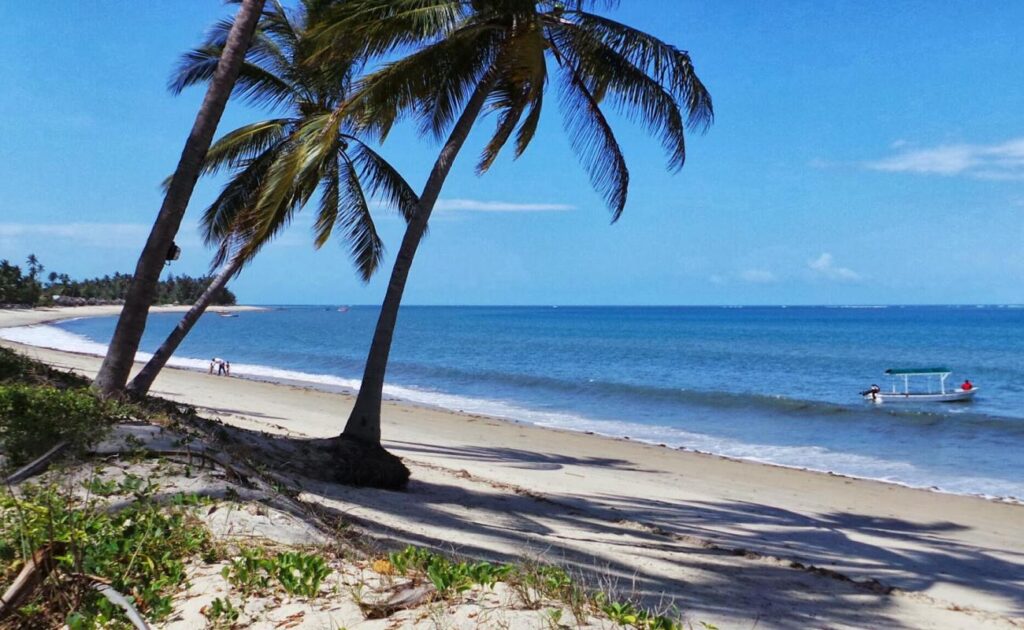Ushongo beach tanzania
Ushongo is located 377 kilometers (234 miles) north of Dar es Salaam and 66 km (41 miles) south of Tanga. A relatively continuous expanse of pristine beach extends north of Bagamoyo for around 322 kilometers (200 miles). Occasionally known as the Pangani Coast, it exemplifies an unblemished, breathtaking shoreline that frequently appears on lists highlighting the world’s most clandestine beaches. If there was a location to reexamine the practice of idleness, this is undoubtedly it. Ushongo Beach, located around 17 kilometers (11 miles) south of the historic Arab slaving town of Pangani, is arguably the most alluring destination to be barefoot beneath a thatched umbrella.

Ushongo is a typical Swahili fishing town, mostly unaffected by tourism; its inhabitants lead a lifestyle seemingly dictated by the tides, with their community extending from palm-leaf cottages to the shoreline. The absence of riptides, sharks, and strong currents renders the sea here ideal for swimming. Crusoe-types require no additional motivation to visit, aside from the magnificent palm-fringed coastline that extends in both directions; nonetheless, further inspiration lies offshore in the sequence of reefs that safeguard Ushongo Bay. The Maziwe Island Marine Reserve is a remarkable, lesser-known scuba diving location, characterized by its vibrant reef teeming with colorful fish, while the adjacent Fungu Island offers excellent snorkeling opportunities. Pangani is regarded as one of the most captivating communities along Tanzania’s coast, exemplifying a relaxed and somewhat underdeveloped manifestation of Swahili coastal culture.
Ushongo Beach Pangani
Pangani is regarded as one of the most captivating settlements on Tanzania’s coast, exemplifying a relaxed and somewhat underdeveloped manifestation of Swahili coastal culture, enriched with elements of Arab and European colonial history. Despite its convoluted history, which obscures the identity of its founder and the exact date of establishment, the town is said to be over 1,000 years old and has historically served as a crucial waypoint on the East African dhow route created by Arab traders. More conservative estimates attribute its origins to the 15th century. Ultimately, it developed into a thriving port linking the inland caravan route from Lake Tanganyika to the ocean; ivory and slaves were exported from this location, while missionaries and explorers arrived to commence their expeditions inland. It is advisable to have a guide accompany you if you plan to tour the town. The oldest structure is the Old Boma (1810), constructed as the residence of an affluent Omani trader who allegedly had slaves interred alive in the foundations to purportedly reinforce them. Despite extensive alterations by the Germans, the structure preserves its original, elegantly carved wooden doors. Located north of Pangani, almost halfway to Tanga, are the remnants of a medieval Swahili settlement, currently referred to as the Tongoni Ruins. If you have a particular interest in archaeological sites, you may like to examine the graveyard here, as some fallen pillars are intricately adorned.
Approximately 1.5 hours north of Pangani, Tanga is the second-largest metropolitan center along the Tanzanian coastline. Once a bustling port town, it now exhibits a sense of lethargy. Ultimately, it is not an undesirable location; but, there is scant need for a visit, and it certainly lacks any attractions compelling enough to interrupt your beach respite. However, you may find yourself in transit here before proceeding to Ushongo, Arusha, Pemba, or Zanzibar. The town, situated on a natural harbor, is primarily industrial rather than recreational, lacking beaches to rival the splendid one at Ushongo. Nonetheless, you may swim at the beach on the little island of Toten, situated within the harbor. For an opportunity to immerse yourself in local culture, attempt to negotiate with one of Tanga’s fishermen for transportation to and from the island on a traditional sailboat. A stroll around the island, exploring the dilapidated mosques, will consume a few hours, after which you may wish to relax on the beach of the Raz Kazone Peninsula, Tanga’s affluent district and the hub of its expatriate activities, where the most luxurious hotel in the area is located. A notable excursion, but not suitable for those lacking a particular interest, is a trip to the Amboni Caves. The limestone caverns, replete with extraordinary narratives (some factual) regarding their use as sanctuaries for criminals and habitats for diverse wildlife, showcase the typical stalactites, stalagmites, and bats, among some distinctive crystal formations. One room functions as a pilgrimage place, referred to as the Mzimuni, or “spirit chamber,” where local villagers present offerings to their ancestors, and individuals from throughout East Africa seek assistance. Local guides often assert that specific cave passages connect to Nairobi, Mombasa, and Kilimanjaro; nevertheless, this claim remains unverified.
